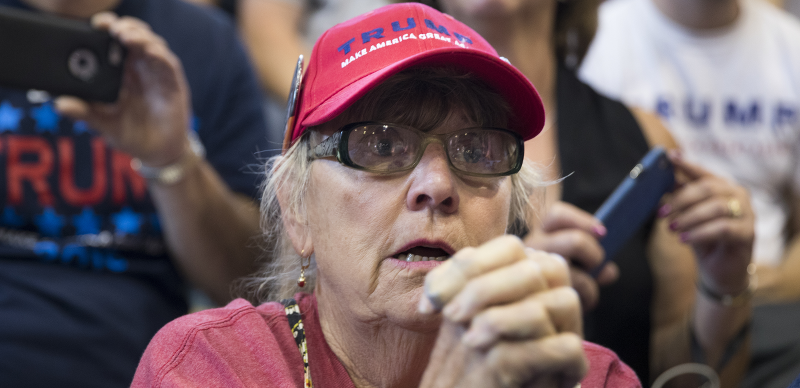Hello, I'm Will Jordan and welcome to the Pulse.
Clinton takes a lead, Trump picks a fight, and Republican senators watch in horror.
So, how about that Democratic convention?
It only ended a week ago, but what a week. Rather than run through the long list of controversial remarks Trump has made recently, let’s take stock on the state of the horserace. Last week Donald Trump received a moderate convention bounce (average when comparing to recent elections, small when looking further back) of a few points, putting him at level-pegging with Hillary Clinton. Following the Democratic convention, a slew of polls have found Clinton leading by around 6 or 7 points on average, suggesting a convention bounce of about that size. Three national polls (Fox News, McClatchy/Marist and NBC/WSJ), conducted a bit later than the others found even bigger leads, and recent swing state polls have found Clinton with significant leads in Michigan, Pennsylvania, Florida and New Hampshire. A poll out this morning even shows her leading narrowly in Georgia.
Will it last?
Nate Cohn argued in the New York Times that Clinton’s bounce could be more durable than Trump’s, in part because data from a CNN poll suggested Clinton was unifying the party, and partisan voters rarely turn back. YouGov’s polling told a different story: half of Sanders primary supporters were still withholding their support; where things moved most in the Democrat’s favor were among independents and groups that traditionally vote Republican. She went from 4 points behind among college-educated white voters to 4 points ahead, and Trump’s lead with men narrowed from 5 to 10. These voters may not stick around, but the programming of the final two days of the convention – speeches by military leaders and Michael Bloomberg, a Democrat-turned-Republican-turned-Independent – initiated a clear effort to push voters disconcerted by Trump’s erratic campaign away from the GOP ticket. And then there was the Khans.
How big a deal was Trump’s feud with the Khan family?
YouGov’s polling finds that Americans widely disapprove of how Trump has handled the criticisms levelled by Khizr Khan and his wife, Ghazala, whose son was killed in Iraq in 2004 (Khizr Khan spoke at the DNC). In particular, Trump’s counterpunch approach to the Gold Star family turned off some of the very voters the Clinton campaign appears to be peel away from Trump. 60% of college educated whites, and a 46% plurality of whites without a college degree rejected Trump’s response. Only 36% of self-identified Republicans and 18% of independents were supportive. Paradoxically, this suggests Trump is in a position to bounce back in a significant way. Recent polls show Trump hovering around 80% among Republicans, the voters who will be most inclined to return to the fold if news around Trump’s campaign improves, as it did after the Republican nominee’s spat with federal judge Gonzalo Curiel.
When will we know if he can bounce back, again?
That will likely depend on Trump’s ability to change the dour narrative engulfing his campaign. That may be more difficult than after the Curiel controversy, when Trump had FBI Director Comey's press conference and a convention on the horizon.
Historically, the noise created by convention bumps have tended to wear off after a few weeks (YouGov’s own Kathy Frankovic recommends not getting too worked up about polls until Labor Day). Recent history has also shown that candidates who trail in the polls at that point don’t win the popular vote. If that’s the case for Trump, attention may start to turn elsewhere.
Where’s that?
Congress! In particular, the Senate. A handful of swing states this election have competitive Senate races, including Pennsylvania, New Hampshire, Ohio and Florida – all currently held by the GOP. Republicans are on defense in two blue states, Wisconsin and Illinois, and a red state, Indiana, which became unexpectedly competitive when a well-known, well-funded former senator entered the race. In North Carolina, Missouri, and Arizona, GOP incumbents are favored, but face credible Democratic opponents poised to take advantage should ripples from a Trump crash-landing crest into a big, blue wave. Democrats need to net four seats to get to 50, in which case a Vice President Kaine could provide the tie-breaking vote.
A recent 538 analysis finds Republican candidates in six of these states running 1-6 points ahead of Donald Trump, suggesting the Senate is well within reach for Democrats if Clinton enters November with a solid lead. This has some pundits and operatives speculating whether – or when – Republican leaders will begin explicitly making the argument that Trump is likely to lose and voters should vote to keep the Senate red as a check on President Clinton’s power. It’s an argument successfully deployed 20 years ago – when it became apparent another Democrat named Clinton had built an insurmountable edge in the polls.
The House of Representatives is a heavier lift for Democrats, but we’ll save that for next week.
Extra reading:
- Josh Katz at the Upshot shows how some – but not all – of the most successful third-party candidates faded in the polls as Election Day approached.
- Democratic polling firm GSG argues voters actually want a president with real experience, not a "true outsider"
- Political scientist Michael Tesler looks at the unique role racial prejudice played in Donald Trump's primary victory
- The GOP is not the only major Western political party in crisis. Anthony Wells of YouGov UK analyzes how a Labour Party split could doom the party's prospects.
The Pulse is a weekly newsletter YouGov has launched ahead of the 2016 primaries and general election to give readers a one-stop-shop for the latest polling-related news from the campaign. In addition to YouGov’s own extensive coverage of the election, The Pulse gives you the five things you need to know about the state of the campaign each week.










